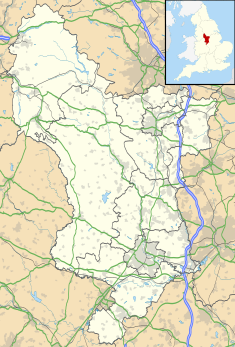| Derby Combined Court Centre | |
|---|---|
 Derby Combined Court Centre Derby Combined Court Centre | |
| Location | Morledge, Derby |
| Coordinates | 52°55′21″N 1°28′23″W / 52.9224°N 1.4731°W / 52.9224; -1.4731 |
| Built | 1989 |
| Architect | Property Services Agency |
| Architectural style(s) | Modernist style |
 | |
The Derby Combined Court Centre is a Crown Court venue, which deals with criminal cases, as well as a County Court, which deals with civil cases, in Morledge, Derby, England.
History
Until the late 1980s, criminal court hearings were held in the County Hall in St Mary's Gate. However, as the number of court cases in the Derby area grew, it became necessary to commission a more modern courthouse. The site selected by the Lord Chancellor's Department, on the north side of Morledge, had accommodated a lead foundry owned by Cox, Poyser and Company before the area was cleared. A 150 feet (46 m) high tower, used for lead shot production, had been a prominent local landmark before it was demolished and replaced with a covered market in 1932.
The new building was designed by the Property Services Agency in the Modernist style, built in red brick at a cost of £7.4 million, and was officially opened by the Lord Chief Justice, Lord Lane, on 17 May 1989. The design involved an asymmetrical main frontage of thirteen bays facing onto Morledge. The left hand section, which was projected forward, was fenestrated with tall casement windows on the ground floor and round headed windows on the first floor. The right hand section featured, on the left, three full-height recesses enclosing three glass doorways leading to an atrium. There was a large Royal coat of arms above the central doorway and, on the right, there were four more bays fenestrated with tall casement windows on both floors. There was also an attic level fenestrated by small bi-partite windows and surmounted by prominent eaves. Internally, the building was laid out to accommodate nine courtrooms.
Notable cases have included the trial and conviction of Jason Lawrance, in March 2016, on five counts of rape against women he met through the online dating service, Match.com, the trial and conviction of John Wass, in August 2017, on 17 counts of historical child abuse which included rape, sexual assault and sexual exposure, and the trial and conviction of Damien Bendall, in December 2022, for the murder of his partner, Terri Harris, and three children.
References
- Historic England. "County Hall (1279174)". National Heritage List for England. Retrieved 12 February 2023.
- Glover, Stephen (1829). The directory of the county of Derby. Henry Mozley & Co. p. viii.
- ^ Tonder, Gerry van (2016). Derby in 50 Buildings. Amberley Publishing. ISBN 978-1445658162.
- "Ordnance Survey Map". 1914. Retrieved 12 February 2023.
- "Capital Building Programme". Hansard. 26 January 1996. Retrieved 12 March 2023.
- "Derby". Ministry of Justice. Retrieved 12 February 2023.
- "Man found guilty of raping women he met on dating website". The Guardian. 2 March 2016. Retrieved 12 February 2023.
- "Match.com rapist jailed for life". BBC. 3 March 2016. Retrieved 12 February 2023.
- "Five more victims of Match.com serial rapist come forward". Lincolnshire Live. 4 October 2019. Retrieved 12 February 2023.
- "Derbyshire child rapist jailed for life". Derby Telegraph. 1 August 2017. Retrieved 12 February 2023.
- "Man sentenced to life for historical child sex offences". ITV News. 31 July 2017. Retrieved 12 February 2023.
- "Life sentence for Chesterfield man guilty of child sex offences dating back to the 1960s". Derbyshire Times. 31 July 2017. Retrieved 12 February 2023.
- "'Brutal' killer handed whole-life term for pregnant partner and child murders". Evening Standard. 21 December 2022. Retrieved 12 February 2023.
- "Killamarsh murderer Damien Bendall facing full life prison sentence". Derbyshire Telegraph. 21 December 2022. Retrieved 12 February 2023.
- "Killamarsh murders: Damien Bendall given whole-life order". BBC News. 21 December 2022. Retrieved 12 February 2023.